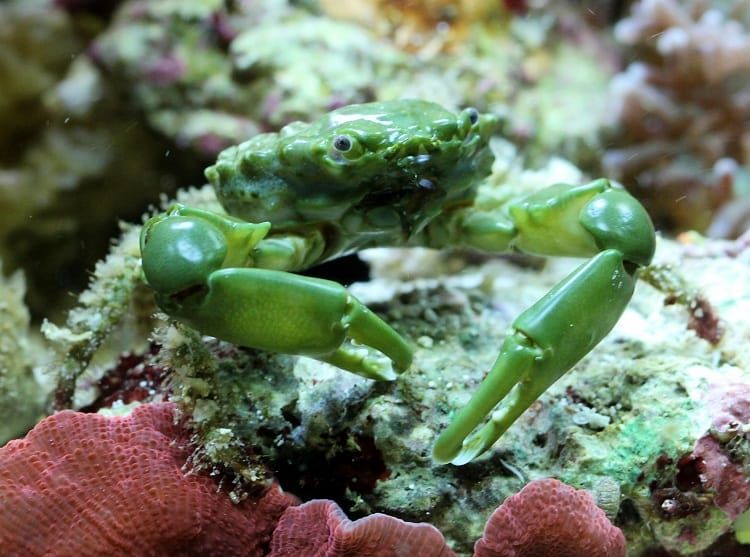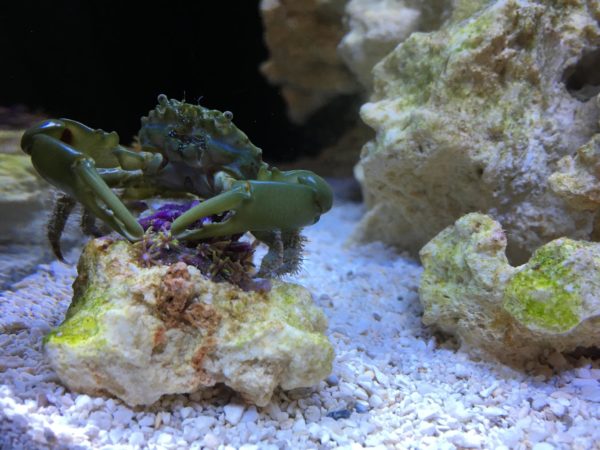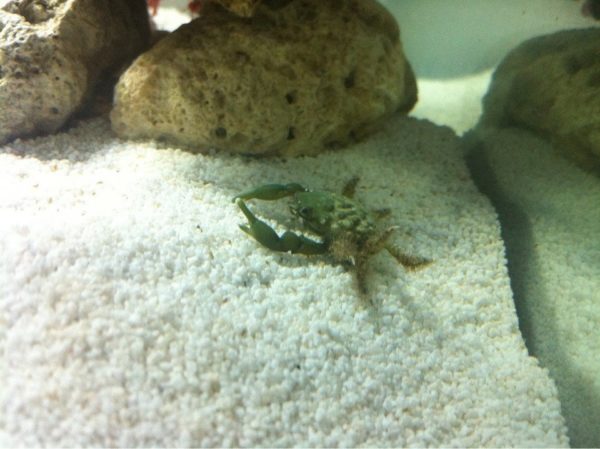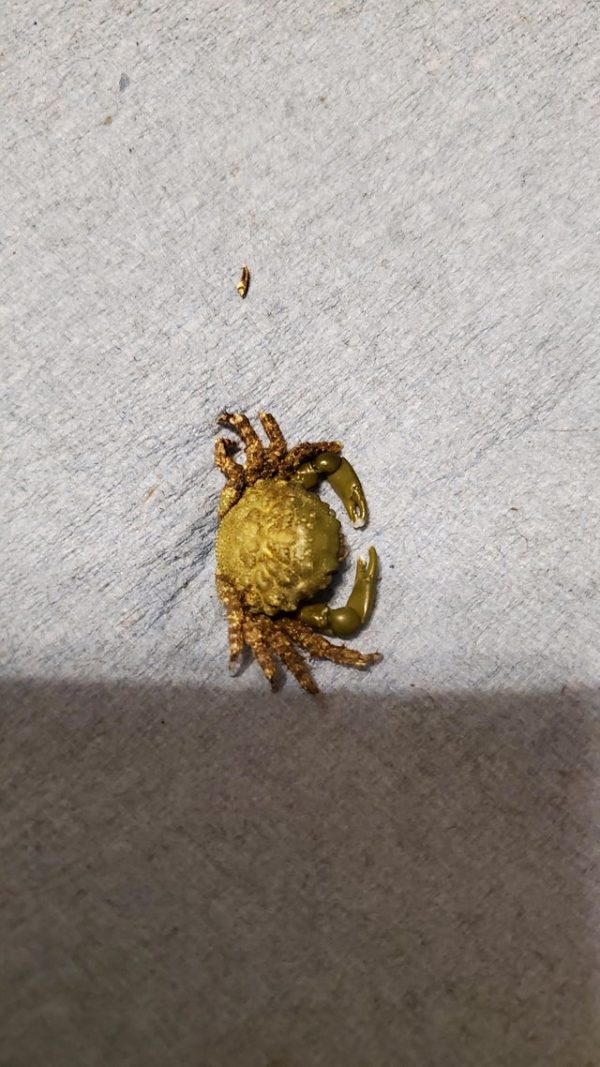When looking for an aquarium cleaner, the Emerald Crab is one of the best sea animals to shop for. Considered a superb algae eater, this crab is also well known for eating up any remnants after feeding the tank fish.

Table of Contents
Emerald Crab Overview
| Information Chart | Emerald Crab |
|---|---|
| Scientific Name: | Mithraculus sculptus |
| Family: | Majidae |
| Care Level: | Easy-Medium |
| Temperament: | Considered safe, may be aggressive |
| Color: | Green |
| Lifespan: | up to 4 years |
| Size: | 6 cm (~2.5 inches) |
| Diet: | Omnivore |
| Minimum Tank Size: | 10 gallons (~40 liters) |
| Temperature: | 24 – 28°C (~75°F – 82°F) |
| Water Conditions: | SG = 1.023 – 1.025 |
| Tank Mate Compatibility: | Low |
Emerald Crab Appearance
The emerald crab is named after its colorful yet distinct appearance. The overall body color is shiny emerald green. It is a few inches in diameter (1.5-2inches) and has hairy legs punctuated with powerful claws. The body is almost flat. A quick glance would give one the impression that it is bubble algae. On the contrary, the latter is a favorite delicacy of the emerald crab.
Because Emerald Crabs have been known to eat reef polyps if they get hungry enough, keeping an eye on your crabs to ensure they are adequately nourished might save you many future problems.

The legs and claws are linked to the carapace, which is long, flat, and shiny. Like other crabs, this one has four pairs of hairy legs, two long and spoon-shaped claws, and white markings on the tips of its feet, just like the others.
Live rock is also a favorite of these little guys, so be sure to give them some to use to make small tunnels to hide in during their molting process. Even if your tank has live rock, it’s conceivable that the current tank inhabitants have already claimed all of the unique hiding spots.
Lifespan of Emerald Crab
An emerald crab’s typical lifespan varies between two and four years, depending on the species. They may not be the world’s longest-living invertebrates, but they can outlast the vast majority of low-cost cleaner shrimp.
In the wild, emerald crabs may live for two to four years; however, in a confined setting such as an aquarium or a marine tank, they can survive for many years longer provided adequate care is taken with their nutrition, water conditions, spawning, and preventing overpopulation so that they can live quietly.
There is no method to forecast one’s life expectancy, as is generally the case. These crabs are vulnerable to the elements and the degree of care you offer.
Emerald Crab Size
The average size of an emerald crab when fully matured is around two inches. However, there is a lot of difference in scope for this species.
You may find tiny specimens less than 1.5 inches long as well as larger ones up to 2.5 inches long. Genetics is responsible for the bulk of this variance.
Natural Habitat and Origin
The crab is an original inhabitant of the Caribbean Sea, with some found in The Gulf of Mexico. Notoriously known for clearing an algae formation, this sea animal is a darling after fish have fed. Most hobbyists who have issues with cleaning up a tank after fish have had their meal are likely to find it an ideal choice. It literally cleans the tank and one may not be obliged to clear any leftovers that are likely to make the aquarium smelly.
Marine or saltwater crustaceans known as emerald crabs are often lurking in crevices and cracks in coral reefs, caves, and crags. They may stay concealed for long periods during the daytime.

In its native habitat, Mithraculus Sculptus, as it is scientifically referred to, is known to be nocturnal. During the daytime, it prefers to hide in caves and crevices. It comes out at night to scavenge for leftovers and grab any algae it is likely to chance upon. When it gets used to a tank, however, it may outlive its shyness and come out of its hiding during the day.
These green crabs are nocturnal, which means that they are most active during the night when they are spawning and foraging. For this reason, shallow water with fluctuating water conditions that foster the growth of algae and the adhesion of coral polyps to rocks would be the best habitat for these crabs to thrive in.
Emerald Crab Tank Size and Specifications
These tiny crabs can live in small tanks and flourish on bigger ones, but they need a small amount of scavenging space. Emerald crabs may become violent in limited places.
Crab density of one per ten liters has worked for certain aquarists. It’s better to be safe than sorry for violent behavior.
Optimum Tank Size for Emerald Crab
A tank with at least 20 to 30 gallons of water is recommended for a single Emerald crab.

Substrate
Begin with a fine sand layer. Create a live rock arrangement after that. When initially introduced to the tank, emerald crabs are primarily nocturnal, and they’ll hide in nooks and caves for most of the day. You’ll see more of them throughout the day as time goes on. Those rocky outcrops, however, are nevertheless vital for shelter.
How Many Emerald Crabs In 20-30 Gallon Tank?
1
Water Parameters for Emerald Crab
Emerald crabs may survive in a wide variety of reef and marine tank setups. They don’t have many preferences, but they like a few things.
Water Temperature
Temperatures of about 75-80 Fahrenheit would be ideal. A pH of 8.4- 8.4. Calcium 420-440 PPM, Magnesium of 1260-1350, Alkaline of 8-9.5 DKH, Nitrates below 10 PPM, Phosphates below 10 PPM. It may raise the water chemistry gradually as it helps create ideal conditions for algae growth. When phosphate levels go up to 10, it is time to make a water change.
Ph Level
8.0 to 8.4
Emerald Crab Tank Landscape
Best Plants for Emerald Crab Tanks
Emerald crabs are like rocky areas abounding with wildlife. To make your crab as comfortable as possible in captivity, try to replicate their natural environment as closely as possible in their aquarium.
According to the description, the crabs will devour creatures that dwell on leaves. It is Turtle grass, Proserpinaca Palustris, and other ground coverings that they are especially fond of.
Worst Plants for Emerald Crab Tanks
You’ve undoubtedly noticed that your Emerald Crab has been fighting with one of your larger fish. In this case, the fish likely attacked the crab, and Emerald crabs get along with most fish and invertebrates.
Avoid putting them in the same tank with predatory fish like triggerfish and puffers, known to feed on them. Additionally, certain hawkfish species are incompatible with emerald crabs, which is a polite way of saying that the hawkfish will stomp on and eat them.
Decorations For Emerald Crab Tanks
Provide live rock so that they find a suitable condition for them to forage into. As a way of ensuring the environment remains friendly to it, dosing pumps may be provided. This will ensure the levels of dosing in the tank are kept constant. Of course some hobbyists do this manually but it is hectic. The pump makes this work easier. Sand and gravel are another necessary addition to fulfill all the tank requirements.
Lighting For Emerald Crab Tanks
You can provide medium lighting in the tank. They like to hide under the live rock when the tank lights are on, and they do not want to have heavy lights in their tank. When the tank lights are off, they come out to eat. After they get used to their new aquarium, they may go out into the open with their tank lights on in search of food and a place to hide.
Feeding Emerald Crab
Crabs are, by nature, scavengers that feed on leftovers. They eat anything from meaty foods to bubble algae in the aquarium and enjoy leafy foods. The emerald crab will be of excellent service to eliminate algae formation in the aquarium.
Most hobbyists assume that since the crab is cleaner, it does not need a special diet. This is not so. Apart from the remnants after the other tank-mates have fed, a supplement diet is necessary. This way, the crab does not seriously interfere with the corals. The crab has an affinity for small fish. Could you not keep the very tiny fish with it when keeping it with tank-mates? The powerful claws can disrupt the body make-up of most types of fish.
Other important information for a hobbyist:
One crab is enough to take care of a tank, and there is no need to stock many of them in a single tank. As much as they feed on algae, it may not eat up a significant formation of it successfully. A massive build-up will call for manual removal and setting the right water conditions that will not favor lots of algae growth.
Crabs shed off their exoskeleton as they age. Once the outer skin is shed off, the remnant is a picture of the real crab. One may think the crab is dead while hiding under rocks or crevices in the tank. It is essential to remove whatever is left behind as it may prevent the build-up of nutrients in the aquarium. Remember, they are scavengers and will gladly feed on the dead fish. This should not appear strange to a first-time hobbyist.
Larger fish find them delicious and may pry on them. When selecting tank-mates, be sure only small friendly ones are in the tank. When kept with other fish, keep a close eye on the tank because they may attempt to claw away part of some fish. While they often attack fish when hungry, there are times when supervising their movements around other fish for a few weeks is necessary.
Best Diet for Emerald Crab
Because Emerald crabs are omnivores, they will flourish in an aquarium with green algae and meaty food.
As the primary source of nourishment, emerald crabs will devour a considerable quantity of algae blooming in your tank.
Emerald crabs are voracious eaters, and one of the main reasons to add one to your tank is to cut down on bubble algae. To make their diet more balanced, you might add dried seaweed and other meaty meals.
They will flourish in old or freshly formed aquariums with enough green algae to eat. Allowing the algae level in the aquarium to drop to the point where there isn’t enough food for the emerald crab to devour is never a good idea.
Other foods to help supplement its diet include:
- Live microalgae
- Nori or seaweed could also be a delicious dish to the crab.
- Mysis shrimp is another delicacy that can add to its diet.
- Formula one fish pellets. Small ones for a start. They are kept in nitrogen bags. This ensures they are soft and easy to digest. If garlic is added to them, the crabs can be disease resistant.
- Krill could be added to the diet too. It enhances the shiny green color.
- You could add spirulina and plankton as well.
Emerald Crab Behavior and Temperament
Other green crabs that infringe on their territory can potentially provoke them into violence. Small fishes and other invertebrates may be taken by the crab and consumed if they do not have enough food to eat on their own.
In some manuals and care sheets, emerald crabs are described as safe and quiet with other tank mates. But there have also been reports of them attacking their tank mates.

If you have any fish, snails, and other crabs, keep in mind that they can get aggressive in some situations. It’s conceivable that the danger may manifest if the tank mates are not appropriately chosen.
Is Emerald Crab a Loner or Social?
Despite their potential for violence, emerald crabs are fascinating to observe. As previously stated, these organisms are primarily nocturnal at first.
Emerald Crab Tank Mates
Emerald crabs like to live in more enormous aquariums with many different species. However, they still need to think about their tank mates when making these decisions.
Ideal Emerald Crab Tank Mates
Because emeralds are tiny, they can outnumber and outcompete other crustaceans even though they are small. Crabs and snails that move very slowly are always a threat.
It’s the same with small fish. It is essential that any fish or marine creature you put in your aquarium can get away from the crab if there are any problems.
Bad Tank Mates for Emerald Crab
Emerald Crabs are known to be hostile against one another. It is thus preferable to keep just one crab in a small tank or a pair of the opposite sex if your tank is limited in space. You should also keep more significant and more aggressive fish away from.
Emerald Crab Breeding
Not much is recorded about breeding the emerald crab in captivity, but there are always first times. Differentiating males from females is difficult. When planning to spawn them, collecting a variety of the crabs and placing them in the same tank can create an opportunity for breeding.

As soon as a crab is six months old, its size doesn’t make a difference in inbreeding. When you look at crabs made of emeralds, they are all capable of having babies.
Some hobbyists have reported observing two crabs locked in something like a tight embrace. This means that even in captivity, there is a likelihood of mating.
When a female green crab mates, she does not lay eggs, but she does have a pouch under her belly where the eggs are stored until the baby crabs are released into the water.
Emerald crabs are a necessity for keeping the tank clean. Taking care of them can be a beautiful experience because they have simple needs.
Emerald Crab Breeding Level
Hard
Emerald Crab Sexual Dimorphism?
The distinction between a male and a female crab is easily discernible. Flipping a boy and a female Emerald crab over and viewing the crab’s underside will reveal the difference.
The pleon (telson/abdomen, the folded part beneath the crab) is smaller in males (resembles a lighthouse), whereas it is broader and rounder in females. Males are also somewhat more extensive and have more enormous claws than females.
Emerald Crab Common Diseases and their Treatment
Shell Illness
One of the most common concerns that emerald crabs confront is shell illness. A viral or bacterial infection typically causes this condition. There’s a chance you’ll see pockmarks on the shell and legs. In severe cases, the disease may eat its way through the shell, causing your crab to die from the inside out.
Facts about Emerald Crab
- When the Emerald crab rips the algal cell apart, the cell fluids, including juvenile cytoplasmic spheres, are expelled into the water.
- Each female crab gives birth to hundreds or thousands of larvae because of the increased production rate of female crabs. However, the population of female crabs has not been determined.
- The Emerald crab’s consumption rate must be faster than the Bubble algae’s pace of development.
- Due to being born in the wild, emerald crab kids do not have unique names. They are sometimes called “zoea larvae” or “ladder crabs” in some places.
- If you have a big, filthy tank, one crab will almost certainly not be able to clean it all by itself.
- Even though they can live in a saltwater tank, they have a strong survival instinct and can adapt to changes in temperature in less than a second.
- Remove the shell from the tank. It’s a good source of minerals and nutrients. It will be consumed by your crab afterward. It may also aid the other critters in the tank.
- Females and males are not named in the same way. Many people use the terms “female crabs” and “male crabs” to talk about them.
Is Emerald Crab Right for You?
Several individuals who have never had a problem with the Emerald crabs are reef safe. Others saw them picking on their SPS corals, removing intergalactic mushrooms from their rocks, and damaging zoa colonies, among other things. They name them Terrors and warn that they should not trust them, that they should never be authorized again, that they are the worst crabs, and so on.
If you’re okay with that, obtaining one of these animals should be a cakewalk! If not, you may still work your way up by keeping them in their tank before introducing other marine species.
FAQs
Do Emerald Crabs Have a Reputation for Being Aggressive?
Emerald crabs are semi-aggressive feeders, preferring corals, reef-associated marine animals, sea anemones, polyps, and coral starfish. They can be aggressive sometimes when they are hungry.
Is Having an Emerald Crab Reef Safe?
For the most part, these crabs do well on reefs.
Is It True That Emerald Crabs Have a Negative Impact on Coral?
In addition to grazing algae, it is an opportunistic omnivore that will scavenge dead animals and even attack and swallow live ones, such as coral polyps and small fishes.
Conclusion
Even though it is one of the most popular and contentious crabs in this hobby, the Emerald crab is still a hotly debated species. Aquarists often use them as a cleaning tool in saltwater tanks to eliminate nuisance algae, mainly bubble algae, which may annoy the fish in the tank. After removing the pest, the concern is that they may attack and severely hurt other organisms and plants in an aquarium, causing significant damage.
No related posts.
